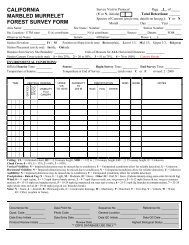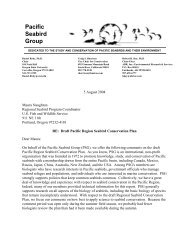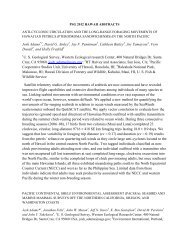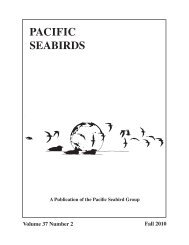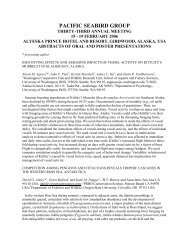abstracts of oral and poster presentations - Pacific Seabird Group
abstracts of oral and poster presentations - Pacific Seabird Group
abstracts of oral and poster presentations - Pacific Seabird Group
You also want an ePaper? Increase the reach of your titles
YUMPU automatically turns print PDFs into web optimized ePapers that Google loves.
JAPAN; 3 U.S. Fish <strong>and</strong> Wildlife Service, Portl<strong>and</strong>, OR USA; 4 U.S. Fish & Wildlife Service, Honolulu, HI<br />
USA<br />
All North <strong>Pacific</strong> albatrosses are listed as threatened by the IUCN; therefore, detection <strong>of</strong> changes in<br />
their populations is critical. We analyzed colony surveys <strong>of</strong> these species across their range for the period <strong>of</strong><br />
1976 to the present. The population <strong>of</strong> Short-tailed Albatrosses (Phoebastria albatrus) currently consists <strong>of</strong><br />
2,000 birds, is distributed between the Senkaku <strong>and</strong> Torishima breeding colonies, <strong>and</strong> is growing at 7.5%/year.<br />
The Black-footed Albatross (P. nigripes) population contains 290,000 birds, with 95% <strong>of</strong> the pairs nesting in<br />
Hawaii <strong>and</strong> the remainder on Japanese isl<strong>and</strong>s. In Hawaii, Black-footed Albatross populations appear to be<br />
declining slightly, while, on Torishima, the population is growing at 8.5%/year. The Laysan Albatross (P.<br />
immutabilis) population consists <strong>of</strong> 3.1 million birds, nests primarily in the Hawaiian Isl<strong>and</strong>s, <strong>and</strong> appears to be<br />
increasing slightly. We project population changes for all three albatross species under several scenarios <strong>of</strong> agespecific<br />
survival <strong>and</strong> fecundity.<br />
PROTECTING PENGUINS WITH CREATIVE OCEAN ZONING IN THE SW ATLANTIC<br />
Elizabeth Skewes* (skewes@u.washington.edu) <strong>and</strong> P. Dee Boersma; Department <strong>of</strong> Biology, University <strong>of</strong><br />
Washington, Seattle, WA USA<br />
Less than 0.5% <strong>of</strong> the oceans are protected (compared with 11.5% <strong>of</strong> the Earth’s l<strong>and</strong> surface), <strong>and</strong> the<br />
status <strong>of</strong> many marine species continues to deteriorate. Strong political <strong>and</strong> economic forces oppose the creation<br />
<strong>of</strong> protected areas that would restrict exploitation <strong>of</strong> marine resources. In the SW Atlantic, human activities<br />
such as fishing, shipping, oil exploration <strong>and</strong> transport, <strong>and</strong> pollution are putting increasing pressure on marine<br />
ecosystems. Most Magellanic Penguins migrate north from their colonies along the Atlantic coast during the<br />
austral winter, following a “highway” along the coast from May to July. We document that few marine areas<br />
around Magellanic Penguin breeding colonies are currently protected <strong>and</strong> that the penguin migration route has<br />
no protection. Because the birds remain for the most part inside the exclusive economic zone (EEZ) <strong>of</strong> coastal<br />
nations, penguin protection can be implemented at a national level. We propose the designation <strong>of</strong> a national<br />
park with temp<strong>oral</strong> zones to protect penguins <strong>and</strong> their prey sources during migration <strong>and</strong> wintering. This novel<br />
approach <strong>of</strong> having a spatial <strong>and</strong> temp<strong>oral</strong> protected area for a few months <strong>of</strong> the year could minimize conflicts<br />
between people <strong>and</strong> penguins, with little impact on human economic activities.<br />
WHERE TO FISH FORAGING ECOLOGY AND HABITAT USE OF JUAN FERNANDEZ PETRELS<br />
DURING CHICK REARING<br />
Jo Smith* (josmith@u.washington.edu); University <strong>of</strong> Washington, Seattle, WA USA<br />
During chick-rearing, long-lived pelagic birds must balance adult body condition against the flow <strong>of</strong><br />
energy to chicks. Some groups, in particular procellariiforms, use alternating short- <strong>and</strong> long-duration trips to<br />
meet these dem<strong>and</strong>s. I am interested in the linkages between adult behaviours, the use <strong>of</strong> oceanic habitats, <strong>and</strong><br />
ultimately, chick growth or survival. Using a combination <strong>of</strong> data from bird-borne archival data loggers,<br />
remotely sensed (satellite) data, <strong>and</strong> colony studies during early <strong>and</strong> late chick rearing, I am studying the<br />
foraging ecology <strong>of</strong> Juan Fernández Petrels (Pterodroma externa), an endemic seabird <strong>of</strong> the Robinson Crusoe<br />
Isl<strong>and</strong>s, Chile. In 2004, foraging trips lasted between 1 <strong>and</strong> 18 days (mean 4.1; n = 87 trips), with both short (1–<br />
3 d) <strong>and</strong> long (4–18 d) trips observed in marked birds. One-third <strong>of</strong> all chicks were fed on any given night, <strong>and</strong><br />
individually marked adults (n = 53) made 1 to 3 provisioning trips (n = 24 nights; 18 Feb–13 Mar). Adults<br />
traveled to oceanic habitats characterised by minimal sea-surface temperatures ranging from 10° to 20°C (n = 16<br />
trips), placing them in the Subtropical Zone, coastal-upwelling areas (Humboldt Current), or Subantarctic Zone.<br />
Cold water masses (



